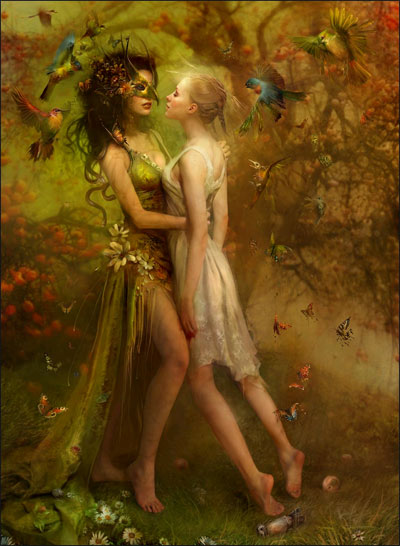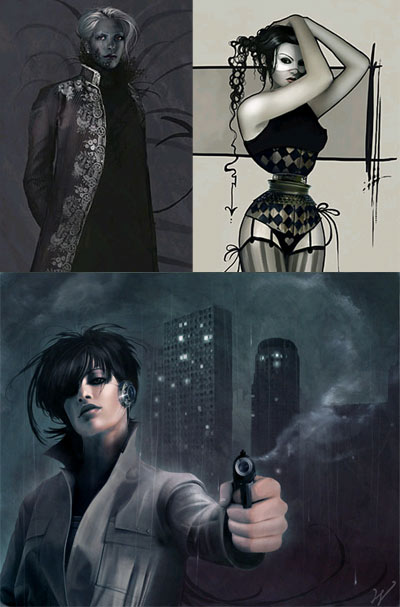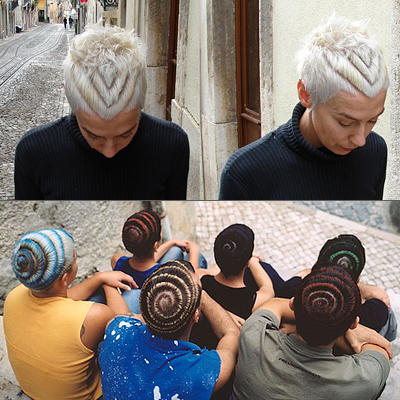When I first followed Beth’s suggestion and looked over Jeremy Harris’ website, my love of portraits naturally drew me to that section of his portfolio. The style there didn’t appeal to me at all – not stylized enough for my taste. But it turns out that’s precisely what makes his photos of asylums so spot on.

With so many photographers using lights and Photoshop to accentuate spookiness when capturing old hospitals and decaying buildings, Jeremy’s plain, day-lit images stand apart. There is a simple honestly that allows us to not dwell on various effects, however pretty they might be, but instead reveals the heart of these spaces. The result is more brutal and attractive than one might expect.

Posted by Zoetica Ebb on April 3rd, 2008
Filed under Art, Madness, Photography | Comments (12)

Unicorn tank illustration by Roman Papusev. Larger here.
These steam-powered unicorn tanks belong to the world of “Black Ice Heart” a Russian novel-in-progress by Leonid Alekhin. The plot of the book is not yet fully known; Alekhin releases only snippets of scenes and dialogue on his journal. From what I’ve been able to translate, the story takes place on the fictitious continent of Akemon, which is devastated by technological revolution. The continent’s technology runs on a combustible mineral called Phlogiston, and its scientific secrets are based on the learnings of four ancient tribes. The inheritors of this knowledge became the houses of four different territories (Diamond, Emerald, Ruby and Sapphire), and each house developed its own pattern of technology as a result. The steam tanks belong to the Diamond territory, and they use it to defend themselves against aggression from the south (from the Ruby and possibly other territories).

Another take on The Unicorn by Boris Kharlamov. Larger here.
Most of the novel’s illustrations come from the talented Roman Papsuev. Here are the other illustrations from the story so far:
This looks like it’s going to be an interesting story! The atmosphere reminds me of what Philip Pullman created for the amazing His Dark Materials Trilogy, on which the film The Golden Compass was based. As Alekhin reveals more of the story, I’m really hoping to see some interesting female characters as well.
Posted by Nadya Lev on April 3rd, 2008
Filed under Art, Books, Russia, Steampunk, Uber | Comments (4)

Women Observing Stars 1936 Chou Ota, Japan
I recently saw this at the National Museum of Modern Art in Tokyo and was floored, immediately. The presence of a telescope in such a traditionally-executed piece was remarkable enough; it’s an infiltrator, hard geometric lines clashing with soft strokes of the figures. But it was the main observer’s fixed gaze that drew me in. Hands firmly gripping the mechanism, she seems completely removed from the rest of the group, lost in stars.
And for all ye brave Steampunk hooligans and aethernauts here is a collection of historical telescope and binocular links, as a supplement.
Posted by Zoetica Ebb on April 2nd, 2008
Filed under Art, Cosmos, Japan | Comments (7)

One technique from the book “The Art of Kissing,” published by Hugh Morris in 1936, lends itself well to some sort of steampunk re-imagining:
“Some few years ago, a very peculiar kissing custom arose which deserves mention here because, from it, we can learn how to adapt the method to our modern devices. At that time, when young people got together, they held, what was then known as, “electric kissing parties.” Young people are ever on the outlook for novel ways of entertaining themselves. In fact, when ether was first developed as an anesthetic, the young bloods of the town used to form “ether-sniffing” parties in which they got a perfectly squiffy ether “jag.” But to return to the “electric kisses.” An excerpt from a contemporary writer will, perhaps, give us some idea of what happened: ‘The ladies and gentlemen range themselves about the room. In leap year the ladies select a partner, and together they shuffle about on the carpet until they are charged with electricity , the lights in the room having been first turned low. Then they kiss in the dark; and make the sparks fly for the amusement of the onlookers.’ The same sort of experiment could be performed nowadays, on cold, dry nights when the air is overloaded with electricity.”
You can read the rest of the experiment here. It starts off gently, suggesting that you generate static electricity from the carpet in order to make a spark fly between yours and your lover’s lips. Then things take a more dramatic turn! “Once you have practiced this for some time, you will become so innured to the slight shock that you will seek more potent electric shocks. These can be obtained with the use of an electric vibrator or in fact, any device that is worked from a battery and a coil which steps up the weak 3 volts of the battery.” You can see where this is leading… read on.
The image above — this is what I imagine a successful electric-kissing experiment might look like — comes from a book of alchemical collages by artist Max Ernst called “A Week of Kindness”, which was published only two years before “The Art of Kissing,” in 1934. Coincidence? I also want to mention that I searched high and low for this particular image for maybe 10 minutes before finally finding it on Mer’s Flickr Page. Even while she’s off adventuring in the American Wild, Mer finds a way to contribute to the blog. Mysterious forces are at work.
Posted by Nadya Lev on March 28th, 2008
Filed under Art, Cryptohistory, Sexuality, Steampunk, Ye Olde | Comments (4)

Placid nuns with milky alien-beauty faces, glowing children with otherworldly skin conditions, and the most ordinary faces made strange by details such as a chalk-white complexion, a subtle change in proportions, overly-glassy eyes. These are the images of Russian artist Oleg Dou, who combines conventional photography with graphic rendering techniques to produce matching portraits of unsettling consistency.
Like many other good things, Oleg Dou’s art was introduced to me by Elegy Magazine. Elegy just released Issue 52, which features Alexander Hacke, Thurston Moore, Tim Burton/Johnny Depp, Nick Cave and Lisa Gerrard.

Posted by Nadya Lev on March 25th, 2008
Filed under Art, Magazines, Photography, Russia | Comments (7)
People of Coilhouse! I come to you this day with news of art. Yes, the very first Coilhouse poster is here.

Hand drawn by yours truly, it features an exotic beauty – corseted, headphoned, jetpacked and ready for adventure. Formatted to be printed at 11×17″ she is available for free download here.
Print one, print one hundred, shrink it, pass it out as fliers or stick it full-size to the side of a train – the more you do with it, the better. All we ask is when you do to take a photo and add it to the Coilhouse Flickr pool, even if it’s just hanging in your kitchen. I’ll be under the cover of night, hooded up and armed with a bucket of glue. Photo-documentation to come. Hope you dig it!
We are hoping to have fixed the spamming issue by installing WordPress 2.3.3 and apologize in advance if spam links do appear. Wily bastards, them.
Posted by Zoetica Ebb on March 24th, 2008
Filed under Art, Coilhouse, Sci-fi | Comments (24)

“The gentleman who has the pleasure of tying the final bow owns you.”
– Mr. Pearl, interview
What strikes me about fetish legend/corsetier Mr. Pearl’s images is how much he looks like a true English gentleman – and how, magically, his 18-inch corseted waist works to enhance that image, the opposite of what one might expect it to do.
Mr. Pearl grew up in South Africa and moved to London at the earliest chance after completing his military service. He spent three years in New York in the early 90s, where he did his most intimate published interview, of which there are few. Already a renowned tightlacer by this time, Pearl treated corsetry with such reverence that he insisted on precision in every aspect of his involvement with it; when his New York interviewer described him as a corsetier, he interrupted. “Forgive me,” he said. “I am a designer who employs the corset and lacings into his designs. I am not a corsetier – I have not attained that specialized knowledge. There are only about five left in the whole world now, who possess that art. I hope one day to be amongst them.”
Fast-forward to the 2000s: Mr. Pearl is a successful corsetier, commissioned by Mugler, Lacroix, Galliano and Gaultier when they need a master to produce their corset designs for the runway. Clients include Dita, Kylie Minogue and Jerry Hall. He lives in Paris, and works out an atelier behind the Notre Dame.

Pearl & his creations. Corsets, BW: Michael James O’Brien, color: Francois Nars.
Despite his success, Pearl doesn’t have a flashy website. There’s no web store to offer plastic-boned corsets that bear only his name, no MySpace page and no blog. He’s known for his aversion to modern technology, and his only web interview was handwritten and transmitted by fax.
Posted by Nadya Lev on March 18th, 2008
Filed under Art, Britannia, Fashion, Fetish, Personal Style, Photography, Sexuality, Ye Olde | Comments (17)

Spoiled, by Linda Berkvist. See the close-up details here.
For the most part, CG art’s not really my thing. I love the surface of paper, the texture of layered paint. There are many techniques to fake this on the computer, but in the end, most CG art still feels a bit sterile and dead-eyed to me. But there are some masters whose digital paintings truly live and breathe; one such artist is Linda Bergkvist, known online as Enayla.
From cyberpunk landscapes to enchanted woods, there’s a story being told by every sensuous detail in Bergkvist’s paintings. Some characters look so compelling that I wish there was more than just one painting; that there was a book, movie or comic where I could get to know them better. I wonder how much of a backstory Berkgvist creates as she paints.
Equally as fascinating as the images are the generous tutorials on Bergkvist’s site. She shares her secrets on how to paint eyes, how to mix skintones, how to create hair texture, and how to make brushes, and more. Even for someone who doesn’t paint, it’s interesting to see her paintings in unfinished form as she explains their completion step by step.

Bottom: “On Saturdays.” Top: Details from “Rëzay” and “Is this what we’re coming to?”
Bergkvist has recently revisited the “analog world” to create some stunning masks in papier mache, which she models on this page. More of my favorite images after the jump!
Posted by Nadya Lev on March 15th, 2008
Filed under Art, Fairy Tales, Flora & Fauna, Goth | Comments (17)
Esteemed reader Tanya Vrodova says, “I love cabbage. I will do anything to spread the word about how awesome cabbage is.” To that end, she just introduced me to Chinese multidisciplinary artist Han Bing and his mischievous Walking the Cabbage (2000-2007) series.

Walking the Cabbage in the Subway Beijing, 2004 © Han Bing
Born in 1974 in an poverty-stricken village, Han Bing spent his childhood helping his parents farm the land and was the only student in his class afforded the chance to attend university. There he studied oil painting before moving on to less conventional mediums. His post-university work has focused on creating spontaneous, open-ended discourse that includes members of society who are often excluded or dismissed. He, like many other young Chinese artist, seems compelled to confront the dubious side effects of his nation’s obsession with urbanizing and modernizing at whatever cost.
From Bing’s website:
Walking the Cabbage (2000-2007) series of social intervention performance, video and photography works, Han Bing walks a Chinese cabbage on a leash in public places, inverting an ordinary practice to provoke debate and critical thinking. Walking the Cabbage is a playful twist on a serious subject—the way our everyday practices serve to constitute “normalcy” and our identities are often constituted by the act of claiming objects as our possessions. A quintessentially Chinese symbol of sustenance and comfort for poor Chinese turned upside down, Han Bing’s cabbage on a leash offers a visual interrogation of contemporary social values.

The Cabbage Walking Tribe in Harajuku I, Tokyo, Japan 2006 © Han Bing
Posted by Meredith Yayanos on March 14th, 2008
Filed under Art, Culture, Film, Food, Geekdom, Goth, Photography, Testing your faith | Comments (15)

I’ve recently come across the flickr stream of Hairport – an aptly-named hair salong in Lisbon, Portugal. Since then I’ve wondered, daily, why more people don’t look like this. It’s 2008! The proverbial Future. Why are there not more artistically shorn heads in the world? One thing I notice about these photos is that not everyone’s a teenager – many Hairport clients and employees are established artists, designers and writers in their 30s. We all know it will grow back should we hate it, yes? Why not embrace the endless possibilities instead of the usual trims, streaks and loose layers! Looking at these pictures makes me downright giddy as I envision a world where one couldn’t be hindered by their hairstyle choices, no matter their profession. Perhaps a trip to Lisbon is in order.

Posted by Zoetica Ebb on March 12th, 2008
Filed under Art, Future, Hair | Comments (14)



















